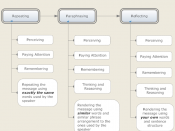Teaching Listening
Listening is a critical element in the competent language performance of adult second language learners, whether they are communicating at school, at work, or in the community. Through the normal course of a day, listening is used nearly twice as much as speaking and four to five times as much as reading and writing . In a recent study of Fortune 500 Corporations, Wolvin and Coakley (1991) found that listening was perceived to be crucial for communication at work with regards to entry-level employment, job success, general career competence, managerial competency, and effectiveness of relationships between supervisors and subordinates. Yet listening remains one of the least understood processes in language learning despite the recognition of the critical role it plays both in communication and in language acquisition . As language teaching has moved toward comprehension-based approaches, listening to learn has become an important element in the adult English as a second language (ESL) classroom.
What are some factors that affect the listening process?
Listening is a demanding process, not only because of the complexity of the process itself, but also due to factors that characterize the listener, the speaker, the content of the message, and any visual support that accompanies the message (Brown & Yule, 1983).
The Listener
Interest in a topic increases the listener's comprehension; the listener may tune out topics that are not of interest. A listener who is an active participant in a conversation generally has more background knowledge to facilitate understanding of the topic than a listener who is, in effect, eavesdropping on a conversation between two people whose communication has been recorded on an audio tape. Further, the ability to use negotiation skills, such as asking for clarification, repetition, or definition of points not understood, enable a listener to make sense of the...


